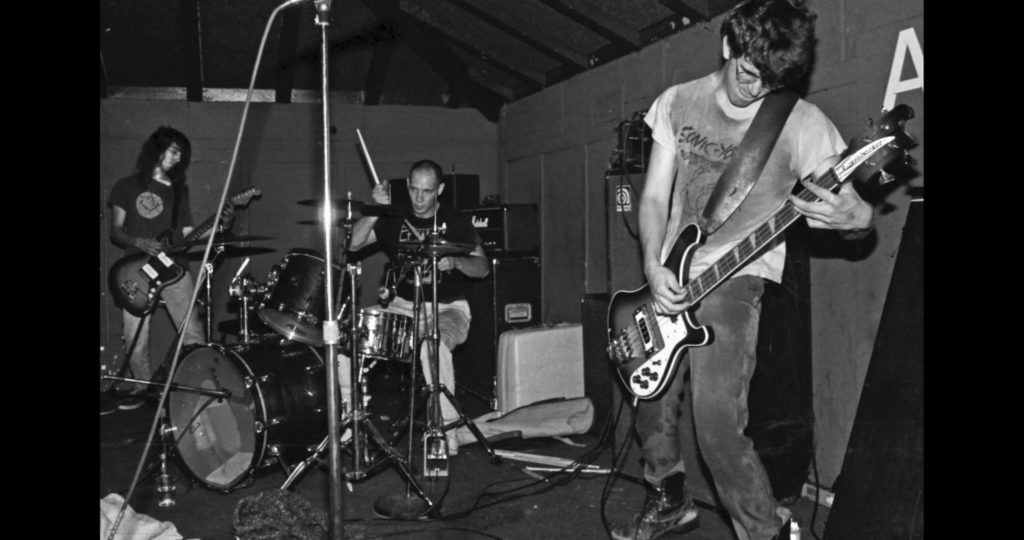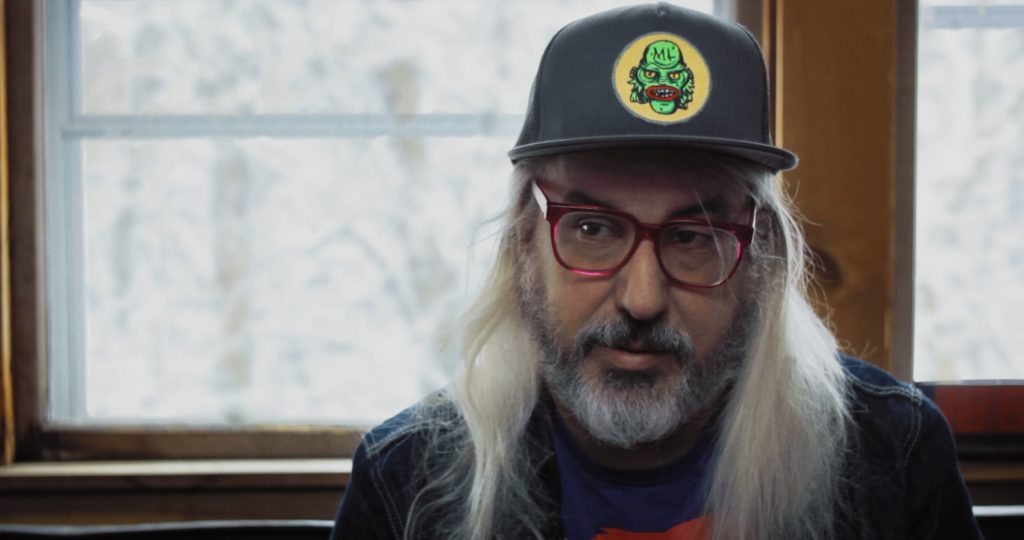
Sometimes I don’t thrill you,
Sometimes I think I’ll kill you,
Just don’t let me fuck up, will you?
Cause when I need a friend, it’s still you.–”Freak Scene,” Dinosaur Jr. (1988)
Anyone who grew up in the glory days of VH1’s Behind the Music will know that documentaries about pioneering rock bands tend to fall into a standard rise-and-fall structure: the heady early days, the meteoric rise, the acrimonious breakup, the amicable reunion. So, on its face, it’s not particularly surprising in Freakscene: The Story of Dinosaur Jr. when guitarist and vocalist J. Mascis wistfully recalls, “That’s when it all fell apart,” while describing an incident on a disastrous US tour. What is unusual is that this incident falls roughly twenty minutes into the feature length doc. As all three principle members note over the course of the film, the dynamic of Dinosaur Jr. is more akin to a dysfunctional family than a group of friends playing music, and, like an actual family, their paths have diverged and reconvened several times over the course of their nearly 40-year (on and off) career.
Hailing originally from the sleepy woods of Western Mass, Dinosaur Jr. consisted primarily as a power-trio: the aforementioned Mascis, the laconic, sleepy-eyed guitar hero who served as the band’s central creative force; bespectacled bassist Lou Barlow, secondary songwriter and nervy yang to Mascis’ yin; and drummer Emmett Jefferson Murphy III, known mononymously as Murph. The group met as high school students in Amherst and quickly exploded in alternative music circles, their sonic assault– a melding of the ferocity and lo-fi aesthetic of hardcore punk with the extended guitar solos and introspective lyrics of ‘70s arena rock– laying the template for what would soon come to be known as “grunge.” But, seemingly no sooner than they started, the cracks started showing, with Barlow’s manic intensity coming at loggerheads with the taciturn but deceptively withering Mascis. The creative partnership imploded in 1989 after releasing just three LPs. In an ordinary story, that would seem to be that.

But, unlike its paleontological namesake, Dinosaur Jr. refused to go extinct. Though Murph would leave a few years later (citing the difficulty of reforging the rhythm section bond he had with Barlow), Mascis led a nominal iteration of Dinosaur Jr. to chart-topping (or at least chart-placing) success through the ‘90s. Barlow, for his part, would go on to found the equally influential indie rock outfit Sebadoh, but memories of his previous band would continue to haunt his lyrics (“The Freed Pig,” about his exit from Dinosaur, stands as one of the most lacerating breakup songs ever written, romantic or otherwise). Despite their often fraught relationship, these three men eventually realized that their bond continued to live inside them, leading to one of the most surprising– and fruitful– rock reunions of the 21st century.
Director Philipp Reichenheim (sometimes credited as Philipp Virus) presents an appropriately shaggy portrait of this perennially shambolic band, stitched together from vintage performance clips, home movies, talking-head interviews with all three principle band members, and testimonials from such friends and fellow alt-rock travelers as Kim Gordon, Henry Rollins, and Bob Mould.* The film takes a more or less chronological approach, tracing the band from its roots in Mascis’ teenage hardcore band Deep Wound to its current reconstituted incarnation, which continues to prolifically tour and record to this day. From start to end, the film is buoyed by its endearingly neurotic (or, in Mascis’ case, monosyllabic) subjects, and by their consistently great music.
I was occasionally frustrated by the lack of context of some of the clips; it’s clear from shifting aspect ratios and the varying shades of white in Mascis’ and Barlow’s beards that some of the interviews were conducted years apart, and it would have been helpful if some of the snippets were dated (the film is presumably a long-gestating project for Reichenheim, who also shot the band’s 2007 Live at the Middle East DVD). I was also, as a longtime fan, somewhat disappointed that the film didn’t spend more time on anecdotes from the band’s famously acrimonious ‘80s years, though I would completely understand if the bandmates aren’t eager to talk about this stretch (for a more in-depth telling, I recommend the band’s harrowing chapter in Michael Azerrad’s Our Band Could Be Your Life).

But, of course, these are the opinions of a cranky former record store clerk, and I recognize that viewers outside of the late Gen-X/early Millennial blip will likely be less familiar with Dinosaur’s ear-bleeding charms. Like last year’s winning The Sparks Brothers, Freakscene serves as an engaging jumping-on point for newly converted acolytes. The interviews do an excellent job at both contextualizing the band’s music and describing what makes them so special (unsurprisingly, the MVP here is Rollins, who at this point is as notable as an oral historian of underground music as he is as a musician himself). And, unlike in similar documentaries, several of the group’s best songs are allowed to play in near-entirety, from their cheeky-yet-earnest cover of The Cure’s “Just Like Heaven” to the Spike Jonze-abetted MTV hit “Feel the Pain.” This is all on top of a wealth of priceless performance footage spanning the band’s career; a jaw-dropping clip of a late ‘80s gig ending with a literal onstage fistfight between Mascis and Barlow is worth the price of admission alone.
In a rock idiom that values authenticity over all else, Dinosaur Jr. is realer than most: Barlow, despite being a world-renowned musician, still drives his own tour van and crowdsources performance dates via Instagram; Mascis is occasionally sighted, like a rock & roll sasquatch, in such mundane acts as buying a Volkswagen Golf or showing up alone to a karaoke bar. Their infighting wasn’t some stage-managed Kanye-Davidson feud, but a case of three real dudes working out their issues on a semi-national stage. When they reunited, fans wondered how this band who fell out so acrimoniously could not only work together again, but thrive. What Freakscene does most poignantly is answer this question once and for all. They play together because they have to, because their shared creative drive is stronger than their shared aggravation. Anyone who’s ever played in a band– or been in a family– will surely relate.
*Though she’s not the biggest name featured, I was delighted by the presence of Megan Jasper, the Sub Pop employee behind the legendary “Grunge Speak” media hoax.
Freakscene: The Story of Dinosaur Jr.
2021
dir. Philipp Reichenheim
82 min.
Part of the 2022 Boston Underground Film Festival – click here to follow our continuing festival coverage!

